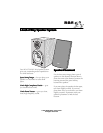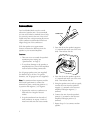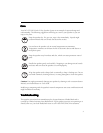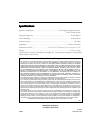
2
C
CC
Co
oo
onn
nnnn
nne
ee
ec
cc
ct
tt
ti
ii
io
oo
on
nn
ns
ss
s
Your local RadioShack store has a wide
selection of speaker wire. We recommend
you use color-coded or marked wire to help
you correctly connect the wire. Most color-
coded wires have a stripe running down one
of the conductors and marked wires have
ridges along one of the conductors.
With the speaker in its approximate
location, measure the distance from the
speaker to your receiver/amplifier.
C
CC
Ca
aa
au
uu
ut
tt
ti
ii
io
oo
on
nn
ns
ss
s:
::
:
• Take care never to exceed the speaker’s
maximum power rating (see
“Specifications” on Page 4).
• To avoid any damage to the speaker or
amplifier/receiver, turn off the amplifier/
receiver before making connections.
Use 18-gauge speaker wire (not supplied)
for distances up to 50 feet. For greater
distances, use 16-gauge wire (not supplied).
N
NN
No
oo
ot
tt
te
ee
e:
: :
: For maximum bass response and the
best overall performance, connect the
terminals in phase, connecting positive (+)
to positive and negative (–) to negative.
1. Separate the wire’s two conductors at
both ends for a length of about 4
inches.
2. Strip the insulation from the ends of
each conductor to expose
1
/
4
-inch of
metal wire and twist the loose strands.
3. Press the tab on the speaker’s negative
(–) terminal and insert one of the wire
ends. Then release the tab.
4. Press the tab on the speaker’s positive
(+) terminal and insert one of the wire
ends. Then release the tab.
5. Using the speaker wire’s code as a guide,
connect the wire from the speaker’s
negative (–) terminal to the receiver/
amplifier’s left/right negative (–)
terminal.
6. Connect the wire from the speaker’s
positive (+) terminal to the receiver/
amplifier’s left/right positive (+)
terminal.
7. Repeat Steps 3–6 to connect another
speaker.
1
/
4
Inch
4 Inches
Conductors






